Cruisin' to Crozon
posted 6 June 2005
This last weekend, studying the maps and guides in search of an interesting Sunday drive with a good restaurant at the far end, we settled on the Crozon peninsula. Four peninsulas jut out westward from the end of Brittany: The big one that Best is on the south side of and that we live near the end of, a smaller one west of Quimper that ends in the "Pointe du Raz," an even smaller one between the first two (the Crozon peninsula), and a very small one between it and Brest (the Plougastel peninsula, where the best strawberries are grown). Inthe town of Crozon, most of the way out the peninsula, is "Le Mutin Gourmand," which is a G-M 13/20. "Lutins" and "mutins" (I'm not sure of the difference) are the Breton equivalent of leprechauns, small elves or imps that go around, apparently, being emblematically Celtic. They are not to be confused with "f&ecute;es," fairies, which are the traditional beautiful young women with gauzy wings. Tinkerbell, for example, is a "Fée, not a lutin or mutin.
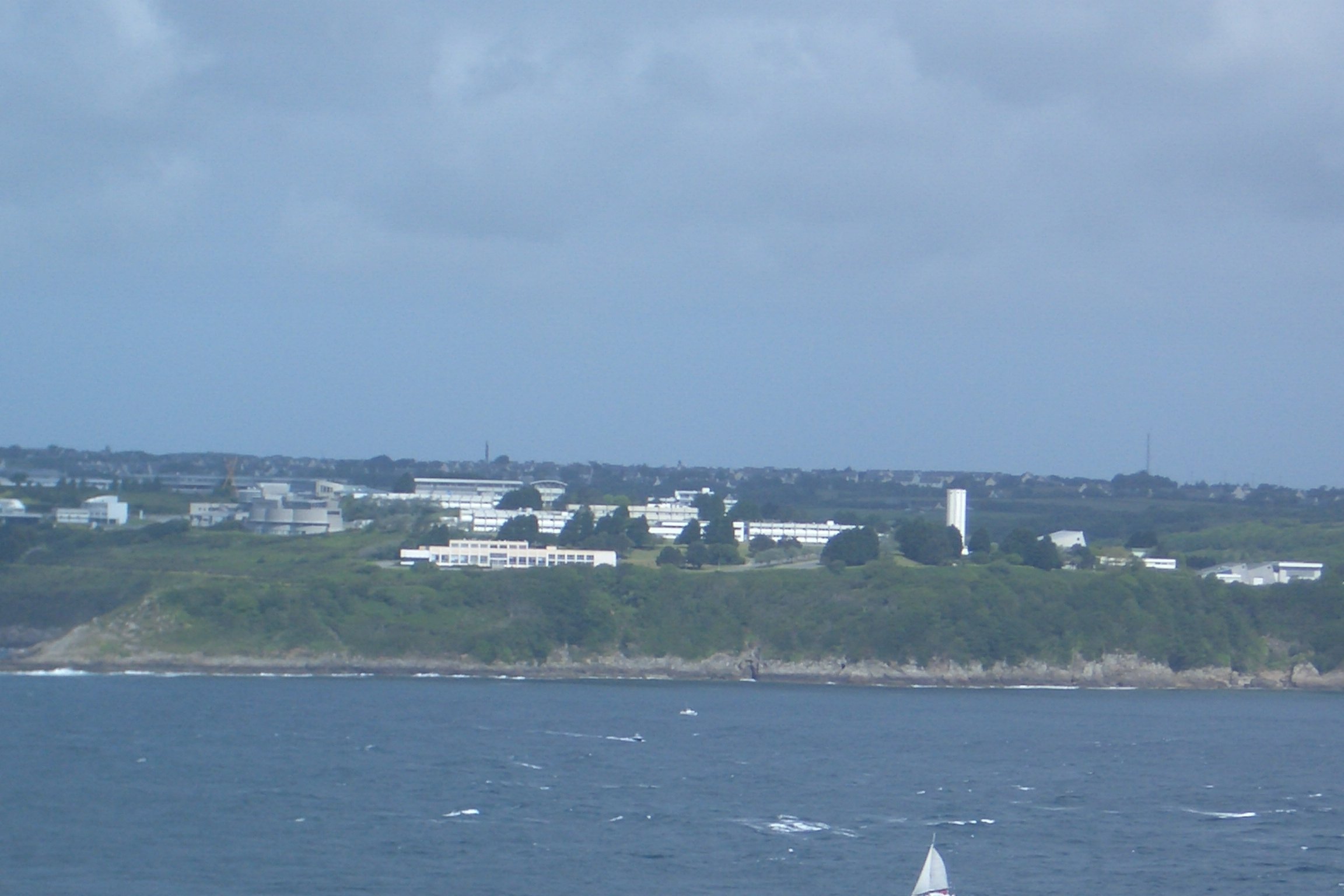 The whole peninsula is incredibly picturesque and scenic, and at its western end splits again into several smaller peninsulas. We started by visiting the northernmost, the Pointe des Espagnols, which happens to be directly across the "Goulet de Brest" (the narrow spot in the approach to the Rade de Brest, the city's very large sheltered harbor) from Ifremer. In the picture (slightly telephoto'ed), the nearest building is the Ifremer cafeteria, and the building directly above it is where we sit. The tall cylinder at the right is the Ifremer water tower.
The whole peninsula is incredibly picturesque and scenic, and at its western end splits again into several smaller peninsulas. We started by visiting the northernmost, the Pointe des Espagnols, which happens to be directly across the "Goulet de Brest" (the narrow spot in the approach to the Rade de Brest, the city's very large sheltered harbor) from Ifremer. In the picture (slightly telephoto'ed), the nearest building is the Ifremer cafeteria, and the building directly above it is where we sit. The tall cylinder at the right is the Ifremer water tower.
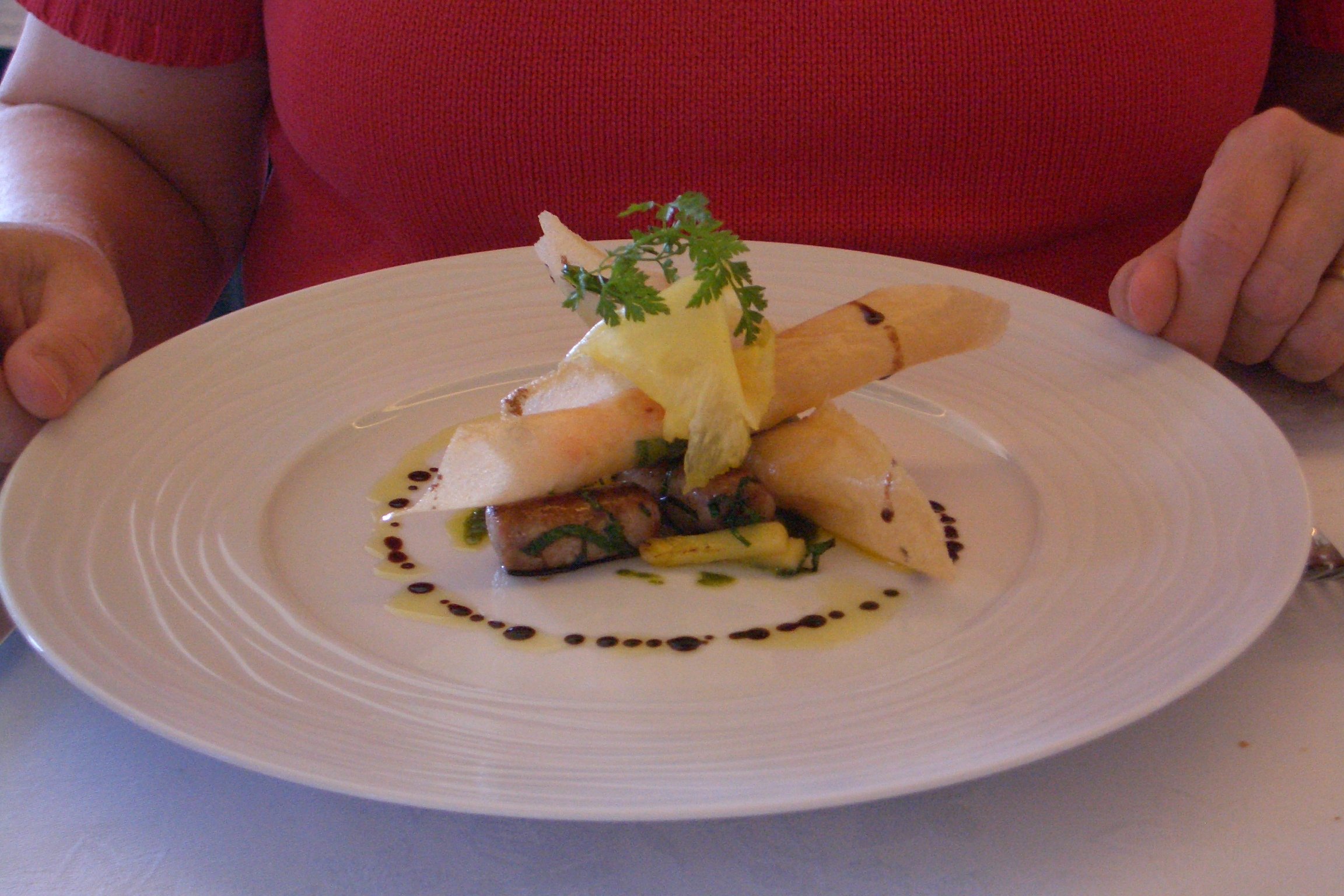 Lunch was great. I think the Mutin deserves better than a score of 13. My main course could have used a little work (I don't hold with this newfangled sautéeing of sweetbreads directly from the raw state—the traditional parboiling and pressing gives a much better texture), but otherwise everying was excellent.
Lunch was great. I think the Mutin deserves better than a score of 13. My main course could have used a little work (I don't hold with this newfangled sautéeing of sweetbreads directly from the raw state—the traditional parboiling and pressing gives a much better texture), but otherwise everying was excellent.
Amuse bouche: a hot filo triangle filled with a hot pâté of pigeon and pigeon liver, small salad on the side that included some chickweed and watercress
 1st course: "tarte fine" of line-caught "bar" (Dicentrarchus labrax, the same fish called "loup de mer" in the south of France and known in English by the entirely unhelpful name "sea bass")—a disk of crisp puff pastry topped by "petals" of semi-dried roasted tomato alternating with slices of roasted fish, in turn topped with tapenade of black olives and dill sprigs; the whole thing was drizzled and surrounded by basil-infused olive oil
1st course: "tarte fine" of line-caught "bar" (Dicentrarchus labrax, the same fish called "loup de mer" in the south of France and known in English by the entirely unhelpful name "sea bass")—a disk of crisp puff pastry topped by "petals" of semi-dried roasted tomato alternating with slices of roasted fish, in turn topped with tapenade of black olives and dill sprigs; the whole thing was drizzled and surrounded by basil-infused olive oil
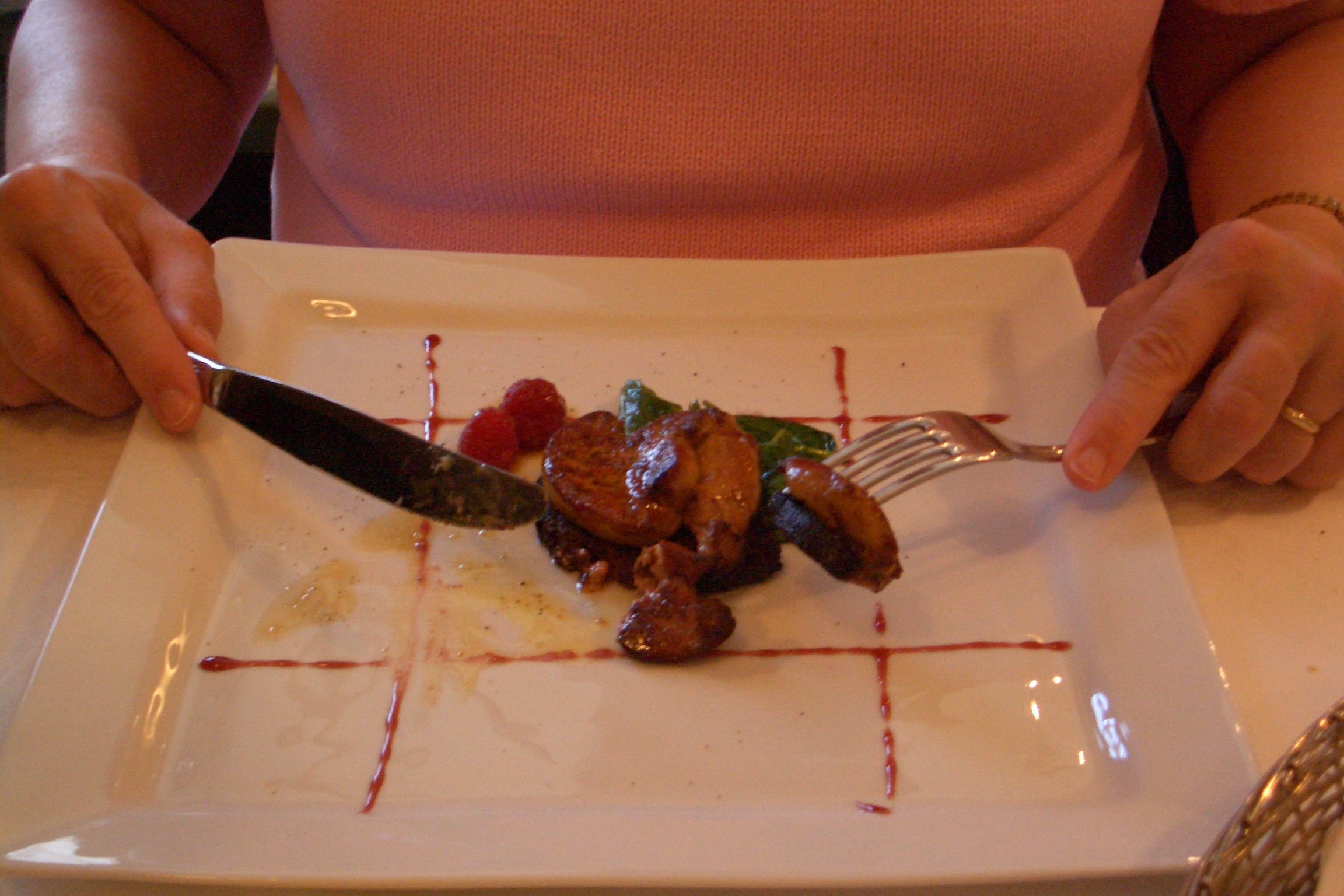 2nd course: hot sautéed foie gras on a slice of toasted gingerbread with a little heap of sautéed spinach; garnished with three raspberries and four streaks of a sweet and sour mixture of raspberry jam and raspberry vinegar
2nd course: hot sautéed foie gras on a slice of toasted gingerbread with a little heap of sautéed spinach; garnished with three raspberries and four streaks of a sweet and sour mixture of raspberry jam and raspberry vinegar
David's main course: sole with almonds garlic and dill; zucchini and a buckwheat "cookie" on the side
My main course: veal sweetbreads with baby carrots, snow peas, and highly seasoned rice pilaf
My cheese: an assortment of French cheeses: fourme d'Ambert (much better than in Caranatec), Comté, boulette d'Avesnes (an old friend; a bizarre, strong, herb-flavored cheese molded into a tall cone and dyed bright orange; it's made from maroille cheeses that are damaged in the aging process), a cylindrical log of chevre, and an extremely ripe St. Maur (an ash-coated chevre) that was making a break for it across the plate. On the side, a nice bowl of wild salad, including chickweed, clover, and several plants I didn't recognize.
David's cheese: another disk of crisp puff pastry topped with fourme d'Ambert, then sliced pears and baked until the cheese was melted (excellent)
 Dessert: Three spice cookies sandwiched with stewed rhubarb and whipped cream; a ball of "fromage blanc" ice cream; a little heap of stewed rhubarb stalks topped with fresh strawberries and drenched with strawberry syrup.
Dessert: Three spice cookies sandwiched with stewed rhubarb and whipped cream; a ball of "fromage blanc" ice cream; a little heap of stewed rhubarb stalks topped with fresh strawberries and drenched with strawberry syrup.
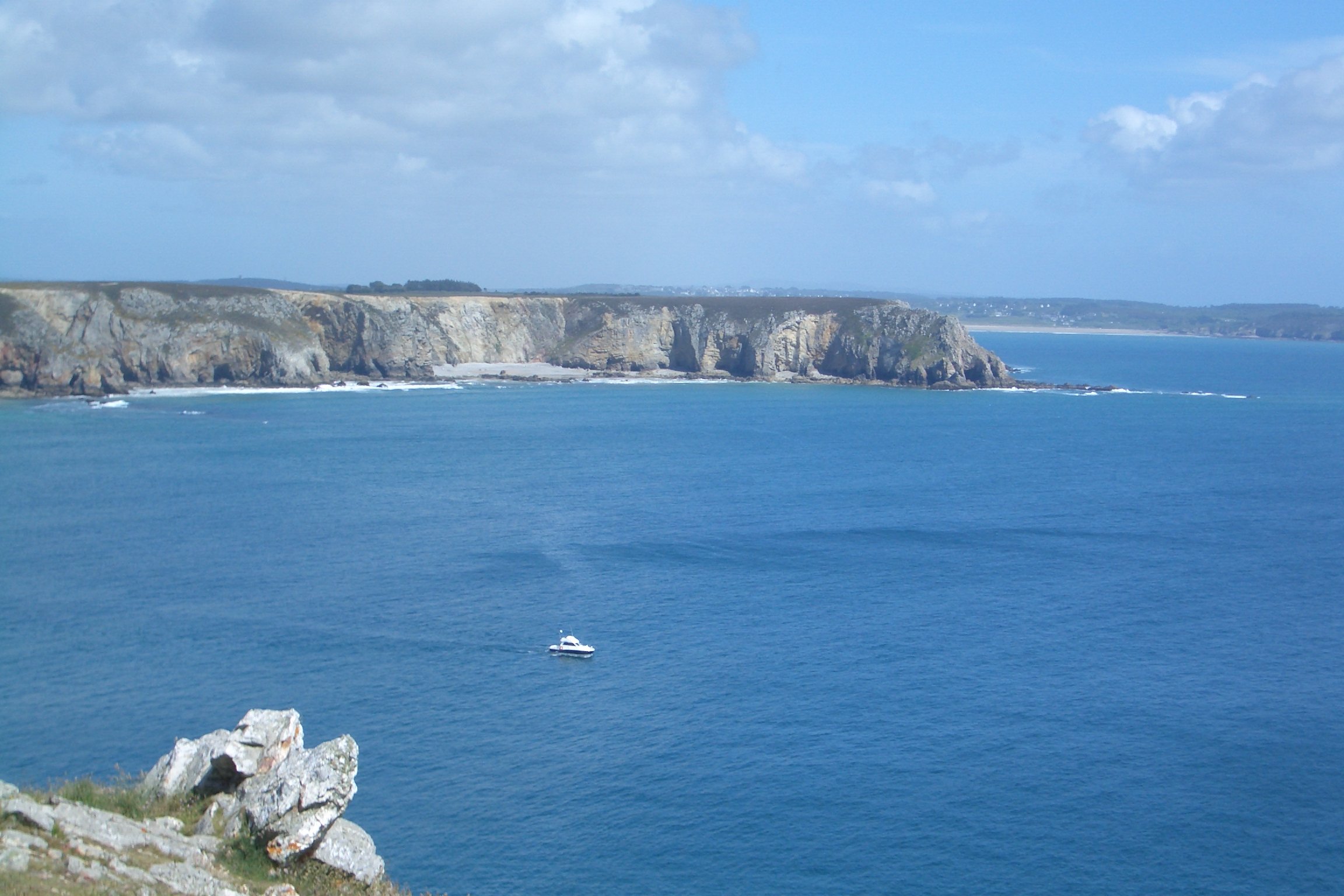 After lunch, we drove around the peninsula some more, visiting two more of the points. The Pointe du Pen Hir is justly reputed to be the most beautiful. Can you believe that's the Atlantic looking that blue? The three rocks off the point are called the "tas de pois" ("pile of peas"). The view is 360-degree panoramic. At the edge of the cliff near where we took these pictures is a sign that says "Climbing area; please don't throw rocks over the edge," and in fact we saw several athletic-looking young people arrive in cars, strap on their harnasses tinkling with carabiners, and disappear over the rim.
After lunch, we drove around the peninsula some more, visiting two more of the points. The Pointe du Pen Hir is justly reputed to be the most beautiful. Can you believe that's the Atlantic looking that blue? The three rocks off the point are called the "tas de pois" ("pile of peas"). The view is 360-degree panoramic. At the edge of the cliff near where we took these pictures is a sign that says "Climbing area; please don't throw rocks over the edge," and in fact we saw several athletic-looking young people arrive in cars, strap on their harnasses tinkling with carabiners, and disappear over the rim.
We also visited the Pointe de Toulinguet, where you can't actually get all the way to the point because the military still occupies the old stone fort there, and its outer wall cuts off the whole end of the peninsula. Spectacular views are still to be had from the sides and around the edges. We could see the steeple at Plougonvelin and got a good view of the lighthouse and ruined abbey at the Points Saint Mathieu, about 5 km from where we live. (That's the lighthouse whose photo is on the "Busy, busy . . ." page).
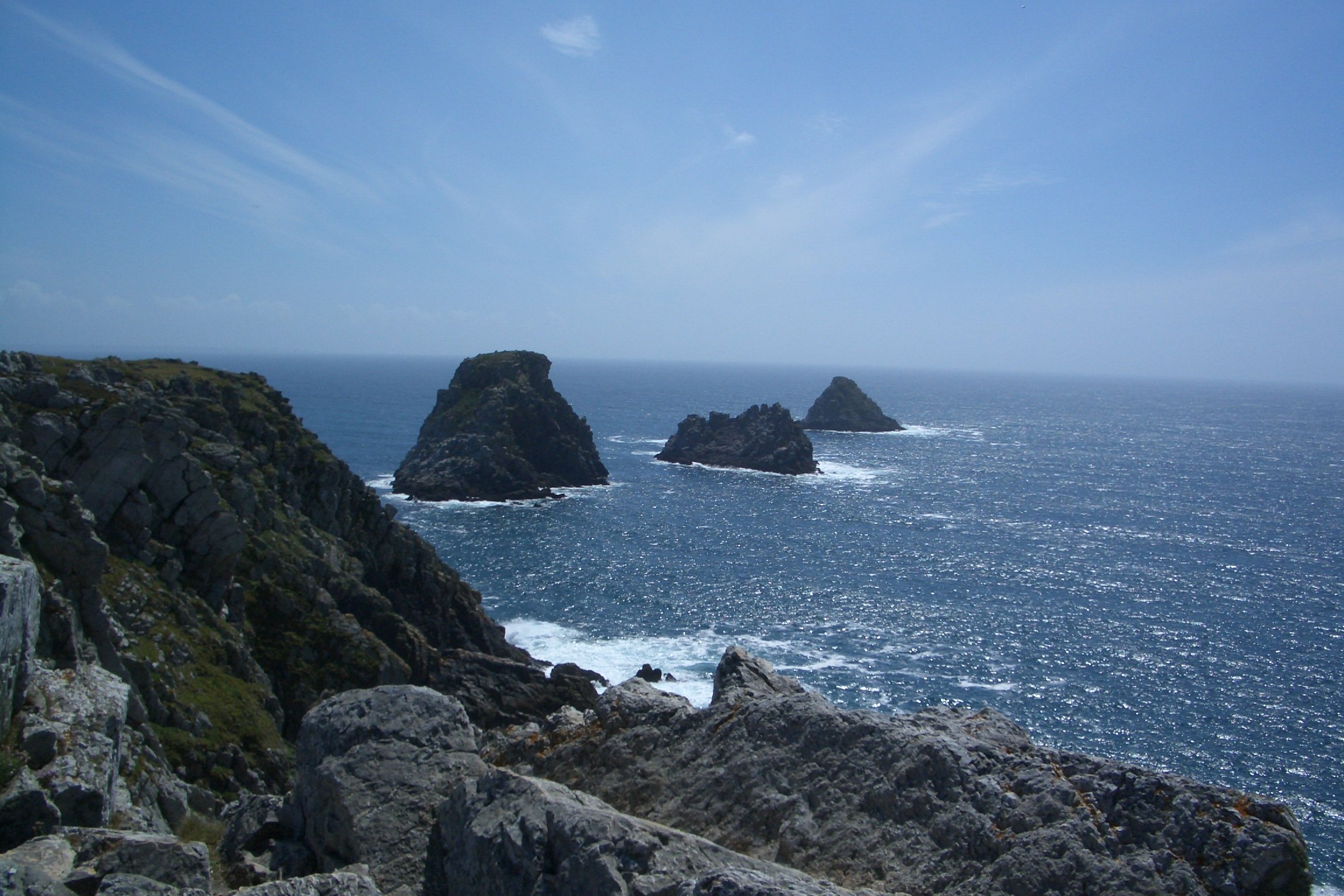 Between Pen Hir and Toulinguet, we drove by the "Alignements de Langatjar," a large and complicated set of aligned standing stones. Unfortunately, although the Michelin green guide recommends that we go and see all these places, it provides precious little actual information about them. We have no idea whether anything is known about the alignments or their purpose, who built the fort and walls at Toulinguet, why the Pointe des Espagnols is called that, or who built the fortifications there, or when. The whole area is also littered with what we recognize (from our travels in Normandy) as German blockhouses, part of the WWII "Atlantic wall," but none of them is signposted or supplied with explanatory panels. We will clearly have to come back sometime, on vacation, and with a more locally oriented guidebook.
Between Pen Hir and Toulinguet, we drove by the "Alignements de Langatjar," a large and complicated set of aligned standing stones. Unfortunately, although the Michelin green guide recommends that we go and see all these places, it provides precious little actual information about them. We have no idea whether anything is known about the alignments or their purpose, who built the fort and walls at Toulinguet, why the Pointe des Espagnols is called that, or who built the fortifications there, or when. The whole area is also littered with what we recognize (from our travels in Normandy) as German blockhouses, part of the WWII "Atlantic wall," but none of them is signposted or supplied with explanatory panels. We will clearly have to come back sometime, on vacation, and with a more locally oriented guidebook.
previous entry List of Entries next entry
 The whole peninsula is incredibly picturesque and scenic, and at its western end splits again into several smaller peninsulas. We started by visiting the northernmost, the Pointe des Espagnols, which happens to be directly across the "Goulet de Brest" (the narrow spot in the approach to the Rade de Brest, the city's very large sheltered harbor) from Ifremer. In the picture (slightly telephoto'ed), the nearest building is the Ifremer cafeteria, and the building directly above it is where we sit. The tall cylinder at the right is the Ifremer water tower.
The whole peninsula is incredibly picturesque and scenic, and at its western end splits again into several smaller peninsulas. We started by visiting the northernmost, the Pointe des Espagnols, which happens to be directly across the "Goulet de Brest" (the narrow spot in the approach to the Rade de Brest, the city's very large sheltered harbor) from Ifremer. In the picture (slightly telephoto'ed), the nearest building is the Ifremer cafeteria, and the building directly above it is where we sit. The tall cylinder at the right is the Ifremer water tower. Lunch was great. I think the Mutin deserves better than a score of 13. My main course could have used a little work (I don't hold with this newfangled sautéeing of sweetbreads directly from the raw state—the traditional parboiling and pressing gives a much better texture), but otherwise everying was excellent.
Lunch was great. I think the Mutin deserves better than a score of 13. My main course could have used a little work (I don't hold with this newfangled sautéeing of sweetbreads directly from the raw state—the traditional parboiling and pressing gives a much better texture), but otherwise everying was excellent.  1st course: "tarte fine" of line-caught "bar" (Dicentrarchus labrax, the same fish called "loup de mer" in the south of France and known in English by the entirely unhelpful name "sea bass")—a disk of crisp puff pastry topped by "petals" of semi-dried roasted tomato alternating with slices of roasted fish, in turn topped with tapenade of black olives and dill sprigs; the whole thing was drizzled and surrounded by basil-infused olive oil
1st course: "tarte fine" of line-caught "bar" (Dicentrarchus labrax, the same fish called "loup de mer" in the south of France and known in English by the entirely unhelpful name "sea bass")—a disk of crisp puff pastry topped by "petals" of semi-dried roasted tomato alternating with slices of roasted fish, in turn topped with tapenade of black olives and dill sprigs; the whole thing was drizzled and surrounded by basil-infused olive oil 2nd course: hot sautéed foie gras on a slice of toasted gingerbread with a little heap of sautéed spinach; garnished with three raspberries and four streaks of a sweet and sour mixture of raspberry jam and raspberry vinegar
2nd course: hot sautéed foie gras on a slice of toasted gingerbread with a little heap of sautéed spinach; garnished with three raspberries and four streaks of a sweet and sour mixture of raspberry jam and raspberry vinegar Dessert: Three spice cookies sandwiched with stewed rhubarb and whipped cream; a ball of "fromage blanc" ice cream; a little heap of stewed rhubarb stalks topped with fresh strawberries and drenched with strawberry syrup.
Dessert: Three spice cookies sandwiched with stewed rhubarb and whipped cream; a ball of "fromage blanc" ice cream; a little heap of stewed rhubarb stalks topped with fresh strawberries and drenched with strawberry syrup. After lunch, we drove around the peninsula some more, visiting two more of the points. The Pointe du Pen Hir is justly reputed to be the most beautiful. Can you believe that's the Atlantic looking that blue? The three rocks off the point are called the "tas de pois" ("pile of peas"). The view is 360-degree panoramic. At the edge of the cliff near where we took these pictures is a sign that says "Climbing area; please don't throw rocks over the edge," and in fact we saw several athletic-looking young people arrive in cars, strap on their harnasses tinkling with carabiners, and disappear over the rim.
After lunch, we drove around the peninsula some more, visiting two more of the points. The Pointe du Pen Hir is justly reputed to be the most beautiful. Can you believe that's the Atlantic looking that blue? The three rocks off the point are called the "tas de pois" ("pile of peas"). The view is 360-degree panoramic. At the edge of the cliff near where we took these pictures is a sign that says "Climbing area; please don't throw rocks over the edge," and in fact we saw several athletic-looking young people arrive in cars, strap on their harnasses tinkling with carabiners, and disappear over the rim. Between Pen Hir and Toulinguet, we drove by the "Alignements de Langatjar," a large and complicated set of aligned standing stones. Unfortunately, although the Michelin green guide recommends that we go and see all these places, it provides precious little actual information about them. We have no idea whether anything is known about the alignments or their purpose, who built the fort and walls at Toulinguet, why the Pointe des Espagnols is called that, or who built the fortifications there, or when. The whole area is also littered with what we recognize (from our travels in Normandy) as German blockhouses, part of the WWII "Atlantic wall," but none of them is signposted or supplied with explanatory panels. We will clearly have to come back sometime, on vacation, and with a more locally oriented guidebook.
Between Pen Hir and Toulinguet, we drove by the "Alignements de Langatjar," a large and complicated set of aligned standing stones. Unfortunately, although the Michelin green guide recommends that we go and see all these places, it provides precious little actual information about them. We have no idea whether anything is known about the alignments or their purpose, who built the fort and walls at Toulinguet, why the Pointe des Espagnols is called that, or who built the fortifications there, or when. The whole area is also littered with what we recognize (from our travels in Normandy) as German blockhouses, part of the WWII "Atlantic wall," but none of them is signposted or supplied with explanatory panels. We will clearly have to come back sometime, on vacation, and with a more locally oriented guidebook.